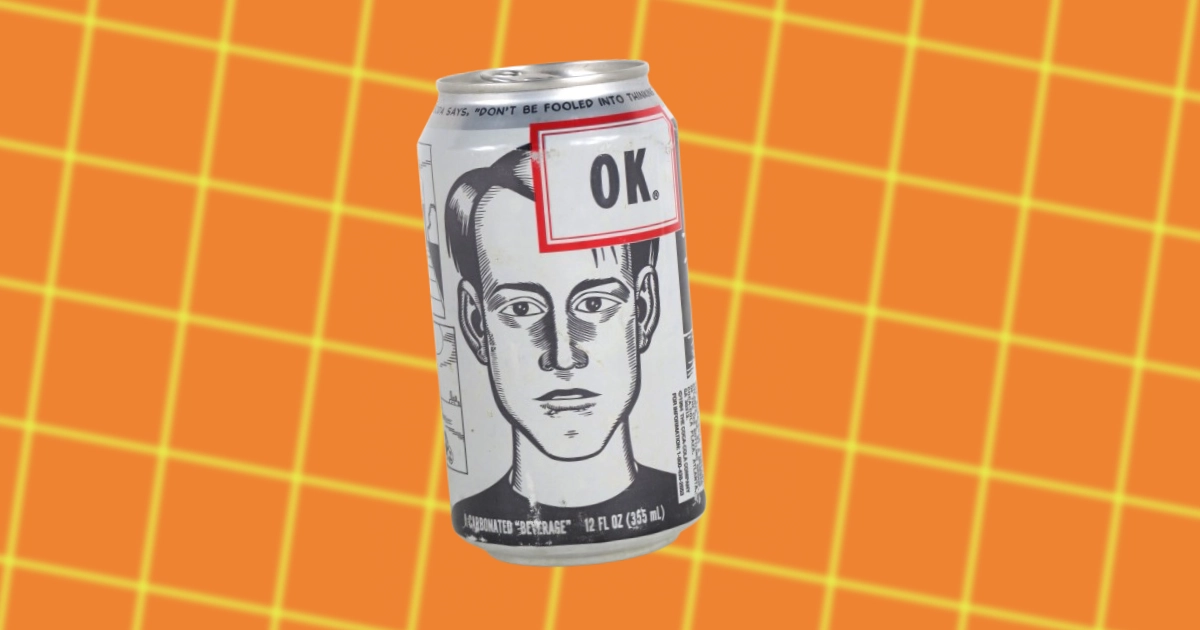
The Coca-Cola Company
"I'm OK, you're OK,"
—OK Soda Slogan
In 1994, Coca-Cola launched OK Soda to capture Generation X consumers.
The drink failed within seven months, despite extensive market research and a $10 million advertising campaign.
While its competitors sold optimism and energy, OK Soda embraced apathy and marketed itself through stark black cans and nihilistic slogans.
The drink's deliberate anti-marketing strategy backfired bigly.

In 1993, Coca-Cola's market research showed their sales dropping among 18-24 year olds.
In response, they launched OK Soda in test markets across the Northwest.
The cans featured black and gray artwork that mimicked underground comics.
The advertisements declared: "What's the point of OK? Well, what's the point of anything?"
Instead of promising happiness or refreshment, OK Soda's marketing embraced confusion and skepticism.
The brand spoke in the same cynical tone as the young people who gathered in coffee shops and record stores, discussing their limited prospects in voices heavy with irony.

Unlike Coca-Cola's upbeat "Have a Coke and a Smile" ads showing friends laughing over cold drinks—OK Soda took a darker path.
The brand spoke in flat, deadpan tones about life's meaninglessness.
Their cans featured grayscale art and slogans like "What's the point of OK? Well, what's the point of anything?"
While other 90s advertisers like Benetton grabbed attention with photos of dying AIDS patients and bloodied soldiers' uniforms, OK Soda's attempt at Generation X irony fell flat.
Customers didn't want existential questions with their carbonated drinks.

In the 1990s, soft drink companies were fighting in a very crowded shelf space.
Coca-Cola and PepsiCo led this fight, launching products that tried new formulas and marketing approaches.
Coca-Cola created OK Soda, targeting teenagers with stark black cans and advertising that questioned corporate messaging.
That same year, PepsiCo released Crystal Pepsi, a colorless cola that confused customers and vanished from shelves by 1994.
.webp)
OK Soda tasted like orange peel mixed with cinnamon and clove, making it unlike any other drink on the market in 1993.
In consumer testing, half of participants rated it below 5 on a 10-point scale, calling it "watery" and "weak," while others gave it 8 or higher, praising its "complex spice notes."
Local newspapers like the Chicago Tribune and Minneapolis Star printed dozens of reader letters about OK Soda, with repeated comparisons to "drinking potpourri" and "spiced cardboard."
The unusual taste, combined with TV ads that never showed the drink itself, left OK Soda with only 3% market share in test cities during its 7-month run.

OK Soda failed in 1995 after Coca-Cola tried to market it using bland acceptance as its core message.
While other 90s drinks like Mountain Dew pushed extreme sports and Sprite aligned with hip-hop culture, OK Soda's name conveyed passive mediocrity.
The name choice mirrors other notable marketing missteps, like when Ford launched the Edsel car line, naming it after the founder's son rather than highlighting any distinctive features.
The car's middle-market position and family-legacy naming contributed to its discontinuation just three years later.
OK Soda’s name projected weakness instead of youth appeal.

OK Soda printed its cans in black and white, using depressing photographs and rough sketches that looked like newspaper illustrations.
This design choice broke from other sodas in 1994.
While Pepsi cans shone in electric blue and Coca-Cola's red practically glowed from store shelves, OK Soda showed grainy faces and random objects in shades of gray.
The contrast was deliberate.
Sprite's green and silver cans promised a clean, bright taste with images of lemon slices and splashing liquid.
OK Soda instead featured sketches that could have been torn from an underground comic book—faces with blank expressions, industrial landscapes, and cryptic messages printed in bold type.

In 1994, OK Soda launched a toll-free hotline that transformed traditional customer service into active marketing.
While other companies used 1-800 numbers for complaints or sales, OK Soda invited callers to listen to manifestos and leave personal messages.
This approach echoed specific marketing innovations from earlier eras.
In 1935, the Major Bowes Amateur Hour radio show pioneered audience participation by asking listeners to call in and vote for their favorite performers.
Similarly, in 2004, Burger King's "Subservient Chicken" website let visitors type commands for a man in a chicken suit to perform, generating 14 million hits in its first year.
OK Soda also distributed physical chain letters, adapting a format previously used for spreading folk tales and superstitions.
These letters instructed recipients to copy and share the message with friends, creating personal networks of brand awareness before email forwards or Twitter retweets existed.
The company placed winning codes inside random soda cans, following the proven success of similar promotions.
Coca-Cola had used this technique in 1955 with their "King Size Prize Contest," hiding tickets worth up to $50,000 inside bottles.
McDonald's later refined this approach with their 1987 Monopoly promotion, which still runs today.
.webp)
OK Soda lasted seven months before Coca-Cola discontinued it in 1995.
This mirrors other notable Coca-Cola product failures like New Coke.
Coca-Cola's 1985 "New Coke" experiment lasted 79 days.
Despite market research, consumer rejection forced a return to the original formula as "Coca-Cola Classic."
OK Soda emerged in the 1990s amid rising skepticism and alternative culture.
While its ironic advertising failed commercially, it pioneered techniques now common in marketing.
Wikipedia - OK Soda